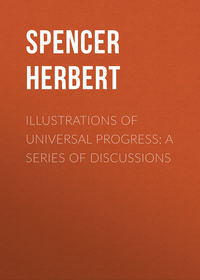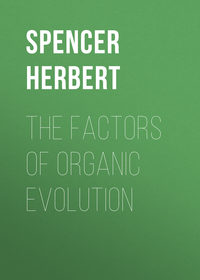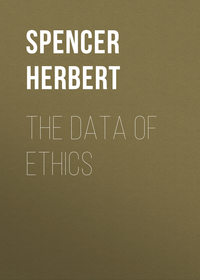 полная версия
полная версияEssays on Education and Kindred Subjects
The advance from the homogeneous to the heterogeneous is displayed not only in the separation of these arts from each other and from religion, but also in the multiplied differentiations which each of them afterwards undergoes. Not to dwell upon the numberless kinds of dancing that have, in course of time, come into use; and not to occupy space in detaining the progress of poetry, as seen in the development of the various forms of metre, of rhyme, and of general organisation; let us confine our attention to music as a type of the group. As argued by Dr. Burney, and as implied by the customs of still extant barbarous races, the first musical instruments were, without doubt, percussive – sticks, calabashes, tom-toms – and were used simply to mark the time of the dance; and in this constant repetition of the same sound, we see music in its most homogeneous form.
The Egyptians had a lyre with three strings. The early lyre of the Greeks had four, constituting their tetrachord. In course of some centuries lyres of seven and eight strings were employed. And, by the expiration of a thousand years, they had advanced to their "great system" of the double octave. Through all which changes there of course arose a greater heterogeneity of melody. Simultaneously there came into use the different modes – Dorian, Ionian, Phrygian, Æolian, and Lydian – answering to our keys; and of these there were ultimately fifteen. As yet, however, there was but little heterogeneity in the time of their music.
Instrumental music during this period being merely the accompaniment of vocal music, and vocal music being completely subordinated to words, the singer being also the poet, chanting his own compositions and making the lengths of his notes agree with the feet of his verses, – there unavoidably arose a tiresome uniformity of measure, which, as Dr. Burney says, "no resources of melody could disguise." Lacking the complex rhythm obtained by our equal bars and unequal notes the only rhythm was that produced by the quantity of the syllables and was of necessity comparatively monotonous. And further, it may be observed that the chant thus resulting, being like recitative, was much less clearly differentiated from ordinary speech than is our modern song.
Nevertheless, in virtue of the extended range of notes in use, the variety of modes, the occasional variations of time consequent on changes of metre, and the multiplication of instruments, music had, towards the close of Greek civilisation, attained to considerable heterogeneity – not indeed as compared with our music, but as compared with that which preceded it. As yet, however, there existed nothing but melody: harmony was unknown. It was not until Christian church-music had reached some development, that music in parts was evolved; and then it came into existence through a very unobtrusive differentiation. Difficult as it may be to conceive à priori how the advance from melody to harmony could take place without a sudden leap, it is none the less true that it did so. The circumstance which prepared the way for it was the employment of two choirs singing alternately the same air. Afterwards it became the practice – very possibly first suggested by a mistake – for the second choir to commence before the first had ceased; thus producing a fugue.
With the simple airs then in use, a partially harmonious fugue might not improbably thus result: and a very partially harmonious fugue satisfied the ears of that age, as we know from still preserved examples. The idea having once been given, the composing of airs productive of fugal harmony would naturally grow up; as in some way it did grow up out of this alternate choir-singing. And from the fugue to concerted music of two, three, four, and more parts, the transition was easy. Without pointing out in detail the increasing complexity that resulted from introducing notes of various lengths, from the multiplication of keys, from the use of accidentals, from varieties of time, and so forth, it needs but to contrast music as it is, with music as it was, to see how immense is the increase of heterogeneity. We see this if, looking at music in its ensemble, we enumerate its many different genera and species – if we consider the divisions into vocal, instrumental, and mixed; and their subdivisions into music for different voices and different instruments – if we observe the many forms of sacred music, from the simple hymn, the chant, the canon, motet, anthem, etc., up to the oratorio; and the still more numerous forms of secular music, from the ballad up to the serenata, from the instrumental solo up to the symphony.
Again, the same truth is seen on comparing any one sample of aboriginal music with a sample of modern music – even an ordinary song for the piano; which we find to be relatively highly heterogeneous, not only in respect of the varieties in the pitch and in the length of the notes, the number of different notes sounding at the same instant in company with the voice, and the variations of strength with which they are sounded and sung, but in respect of the changes of key, the changes of time, the changes of timbre of the voice, and the many other modifications of expression. While between the old monotonous dance-chant and a grand opera of our own day, with its endless orchestral complexities and vocal combinations, the contrast in heterogeneity is so extreme that it seems scarcely credible that the one should have been the ancestor of the other.
Were they needed, many further illustrations might be cited. Going back to the early time when the deeds of the god-king, chanted and mimetically represented in dances round his altar, were further narrated in picture-writings on the walls of temples and palaces, and so constituted a rude literature, we might trace the development of Literature through phases in which, as in the Hebrew Scriptures, it presents in one work theology, cosmogony, history, biography, civil law, ethics, poetry; through other phases in which, as in the Iliad, the religious, martial, historical, the epic, dramatic, and lyric elements are similarly commingled; down to its present heterogeneous development, in which its divisions and subdivisions are so numerous and varied as to defy complete classification. Or we might trace out the evolution of Science; beginning with the era in which it was not yet differentiated from Art, and was, in union with Art, the handmaid of Religion; passing through the era in which the sciences were so few and rudimentary, as to be simultaneously cultivated by the same philosophers; and ending with the era in which the genera and species are so numerous that few can enumerate them, and no one can adequately grasp even one genus. Or we might do the like with Architecture, with the Drama, with Dress.
But doubtless the reader is already weary of illustrations; and our promise has been amply fulfilled. We believe we have shown beyond question, that that which the German physiologists have found to be the law of organic development, is the law of all development. The advance from the simple to the complex, through a process of successive differentiations, is seen alike in the earliest changes of the Universe to which we can reason our way back; and in the earliest changes which we can inductively establish; it is seen in the geologic and climatic evolution of the Earth, and of every single organism on its surface; it is seen in the evolution of Humanity, whether contemplated in the civilised individual, or in the aggregation of races; it is seen in the evolution of Society in respect alike of its political, its religious, and its economical organisation; and it is seen in the evolution of all those endless concrete and abstract products of human activity which constitute the environment of our daily life. From the remotest past which Science can fathom, up to the novelties of yesterday, that in which Progress essentially consists, is the transformation of the homogeneous into the heterogeneous.
And now, from this uniformity of procedure, may we not infer some fundamental necessity whence it results? May we not rationally seek for some all-pervading principle which determines this all-pervading process of things? Does not the universality of the law imply a universal cause?
That we can fathom such cause, noumenally considered, is not to be supposed. To do this would be to solve that ultimate mystery which must ever transcend human intelligence. But it still may be possible for us to reduce the law of all Progress, above established, from the condition of an empirical generalisation, to the condition of a rational generalisation. Just as it was possible to interpret Kepler's laws as necessary consequences of the law of gravitation; so it may be possible to interpret this law of Progress, in its multiform manifestations, as the necessary consequence of some similarly universal principle. As gravitation was assignable as the cause of each of the groups of phenomena which Kepler formulated; so may some equally simple attribute of things be assignable as the cause of each of the groups of phenomena formulated in the foregoing pages. We may be able to affiliate all these varied and complex evolutions of the homogeneous into the heterogeneous, upon certain simple facts of immediate experience, which, in virtue of endless repetition, we regard as necessary.
The probability of a common cause, and the possibility of formulating it, being granted, it will be well, before going further, to consider what must be the general characteristics of such cause, and in what direction we ought to look for it. We can with certainty predict that it has a high degree of generality; seeing that it is common to such infinitely varied phenomena: just in proportion to the universality of its application must be the abstractness of its character. We need not expect to see in it an obvious solution of this or that form of Progress; because it equally refers to forms of Progress bearing little apparent resemblance to them: its association with multiform orders of facts, involves its dissociation from any particular order of facts. Being that which determines Progress of every kind – astronomic, geologic, organic, ethnologic, social, economic, artistic, etc. – it must be concerned with some fundamental attribute possessed in common by these; and must be expressible in terms of this fundamental attribute. The only obvious respect in which all kinds of Progress are alike, is, that they are modes of change; and hence, in some characteristic of changes in general, the desired solution will probably be found. We may suspect à priori that in some law of change lies the explanation of this universal transformation of the homogeneous into the heterogeneous.
Thus much premised, we pass at once to the statement of the law, which is this: —Every active force produces more than one change—every cause produces more than one effect.
Before this law can be duly comprehended, a few examples must be looked at. When one body is struck against another, that which we usually regard as the effect, is a change of position or motion in one or both bodies. But a moment's thought shows us that this is a careless and very incomplete view of the matter. Besides the visible mechanical result, sound is produced; or, to speak accurately, a vibration in one or both bodies, and in the surrounding air: and under some circumstances we call this the effect. Moreover, the air has not only been made to vibrate, but has had sundry currents caused in it by the transit of the bodies. Further, there is a disarrangement of the particles of the two bodies in the neighbourhood of their point of collision; amounting in some cases to a visible condensation. Yet more, this condensation is accompanied by the disengagement of heat. In some cases a spark – that is, light – results, from the incandescence of a portion struck off; and sometimes this incandescence is associated with chemical combination.
Thus, by the original mechanical force expended in the collision, at least five, and often more, different kinds of changes have been produced. Take, again, the lighting of a candle. Primarily this is a chemical change consequent on a rise of temperature. The process of combination having once been set going by extraneous heat, there is a continued formation of carbonic acid, water, etc. – in itself a result more complex than the extraneous heat that first caused it. But accompanying this process of combination there is a production of heat; there is a production of light; there is an ascending column of hot gases generated; there are currents established in the surrounding air. Moreover the decomposition of one force into many forces does not end here: each of the several changes produced becomes the parent of further changes. The carbonic acid given off will by and by combine with some base; or under the influence of sunshine give up its carbon to the leaf of a plant. The water will modify the hygrometric state of the air around; or, if the current of hot gases containing it come against a cold body, will be condensed: altering the temperature, and perhaps the chemical state, of the surface it covers. The heat given out melts the subjacent tallow, and expands whatever it warms. The light, falling on various substances, calls forth from them reactions by which it is modified; and so divers colours are produced. Similarly even with these secondary actions, which may be traced out into ever-multiplying ramifications, until they become too minute to be appreciated. And thus it is with all changes whatever. No case can be named in which an active force does not evolve forces of several kinds, and each of these, other groups of forces. Universally the effect is more complex than the cause.
Doubtless the reader already foresees the course of our argument. This multiplication of results, which is displayed in every event of to-day, has been going on from the beginning; and is true of the grandest phenomena of the universe as of the most insignificant. From the law that every active force produces more than one change, it is an inevitable corollary that through all time there has been an ever-growing complication of things. Starting with the ultimate fact that every cause produces more than one effect, we may readily see that throughout creation there must have gone on, and must still go on, a never-ceasing transformation of the homogeneous into the heterogeneous. But let us trace out this truth in detail.
Without committing ourselves to it as more than a speculation, though a highly probable one, let us again commence with the evolution of the solar system out of a nebulous medium.13 From the mutual attraction of the atoms of a diffused mass whose form is unsymmetrical, there results not only condensation but rotation: gravitation simultaneously generates both the centripetal and the centrifugal forces. While the condensation and the rate of rotation are progressively increasing, the approach of the atoms necessarily generates a progressively increasing temperature. As this temperature rises, light begins to be evolved; and ultimately there results a revolving sphere of fluid matter radiating intense heat and light – a sun.
There are good reasons for believing that, in consequence of the high tangential velocity, and consequent centrifugal force, acquired by the outer parts of the condensing nebulous mass, there must be a periodical detachment of rotating rings; and that, from the breaking up of these nebulous rings, there must arise masses which in the course of their condensation repeat the actions of the parent mass, and so produce planets and their satellites – an inference strongly supported by the still extant rings of Saturn.
Should it hereafter be satisfactorily shown that planets and satellites were thus generated, a striking illustration will be afforded of the highly heterogeneous effects produced by the primary homogeneous cause; but it will serve our present purpose to point to the fact that from the mutual attraction of the particles of an irregular nebulous mass there result condensation, rotation, heat, and light.
It follows as a corollary from the Nebular Hypothesis, that the Earth must at first have been incandescent; and whether the Nebular Hypothesis be true or not, this original incandescence of the Earth is now inductively established – or, if not established, at least rendered so highly probable that it is a generally admitted geological doctrine. Let us look first at the astronomical attributes of this once molten globe. From its rotation there result the oblateness of its form, the alternations of day and night, and (under the influence of the moon) the tides, aqueous and atmospheric. From the inclination of its axis, there result the precession of the equinoxes and the many differences of the seasons, both simultaneous and successive, that pervade its surface. Thus the multiplication of effects is obvious. Several of the differentiations due to the gradual cooling of the Earth have been already noticed – as the formation of a crust, the solidification of sublimed elements, the precipitation of water, etc., – and we here again refer to them merely to point out that they are simultaneous effects of the one cause, diminishing heat.
Let us now, however, observe the multiplied changes afterwards arising from the continuance of this one cause. The cooling of the Earth involves its contraction. Hence the solid crust first formed is presently too large for the shrinking nucleus; and as it cannot support itself, inevitably follows the nucleus. But a spheroidal envelope cannot sink down into contact with a smaller internal spheroid, without disruption; it must run into wrinkles as the rind of an apple does when the bulk of its interior decreases from evaporation. As the cooling progresses and the envelope thickens, the ridges consequent on these contractions must become greater, rising ultimately into hills and mountains; and the later systems of mountains thus produced must not only be higher, as we find them to be, but they must be longer, as we also find them to be. Thus, leaving out of view other modifying forces, we see what immense heterogeneity of surface has arisen from the one cause, loss of heat – a heterogeneity which the telescope shows us to be paralleled on the face of the moon, where aqueous and atmospheric agencies have been absent.
But we have yet to notice another kind of heterogeneity of surface similarly and simultaneously caused. While the Earth's crust was still thin, the ridges produced by its contraction must not only have been small, but the spaces between these ridges must have rested with great evenness upon the subjacent liquid spheroid; and the water in those arctic and antarctic regions in which it first condensed, must have been evenly distributed. But as fast as the crust grew thicker and gained corresponding strength, the lines of fracture from time to time caused in it, must have occurred at greater distances apart; the intermediate surfaces must have followed the contracting nucleus with less uniformity; and there must have resulted larger areas of land and water. If any one, after wrapping up an orange in wet tissue paper, and observing not only how small are the wrinkles, but how evenly the intervening spaces lie upon the surface of the orange, will then wrap it up in thick cartridge-paper, and note both the greater height of the ridges and the much larger spaces throughout which the paper does not touch the orange, he will realise the fact, that as the Earth's solid envelope grew thicker, the areas of elevation and depression must have become greater. In place of islands more or less homogeneously scattered over an all-embracing sea, there must have gradually arisen heterogeneous arrangements of continent and ocean, such as we now know.
Once more, this double change in the extent and in the elevation of the lands, involved yet another species of heterogeneity, that of coast-line. A tolerably even surface raised out of the ocean, must have a simple, regular sea-margin; but a surface varied by table-lands and intersected by mountain-chains must, when raised out of the ocean, have an outline extremely irregular both in its leading features and in its details. Thus endless is the accumulation of geological and geographical results slowly brought about by this one cause – the contraction of the Earth.
When we pass from the agency which geologists term igneous, to aqueous and atmospheric agencies, we see the like ever growing complications of effects. The denuding actions of air and water have, from the beginning, been modifying every exposed surface; everywhere causing many different changes. Oxidation, heat, wind, frost, rain, glaciers, rivers, tides, waves, have been unceasingly producing disintegration; varying in kind and amount according to local circumstances. Acting upon a tract of granite, they here work scarcely an appreciable effect; there cause exfoliations of the surface, and a resulting heap of débris and boulders; and elsewhere, after decomposing the feldspar into a white clay, carry away this and the accompanying quartz and mica, and deposit them in separate beds, fluviatile and marine. When the exposed land consists of several unlike formations, sedimentary and igneous, the denudation produces changes proportionably more heterogeneous. The formations being disintegrable in different degrees, there follows an increased irregularity of surface. The areas drained by different rivers being differently constituted, these rivers carry down to the sea different combinations of ingredients; and so sundry new strata of distinct composition are formed.
And here indeed we may see very simply illustrated, the truth, which we shall presently have to trace out in more involved cases, that in proportion to the heterogeneity of the object or objects on which any force expends itself, is the heterogeneity of the results. A continent of complex structure, exposing many strata irregularly distributed, raised to various levels, tilted up at all angles, must, under the same denuding agencies, give origin to immensely multiplied results; each district must be differently modified; each river must carry down a different kind of detritus; each deposit must be differently distributed by the entangled currents, tidal and other, which wash the contorted shores; and this multiplication of results must manifestly be greatest where the complexity of the surface is greatest.
It is out of the question here to trace in detail the genesis of those endless complications described by Geology and Physical Geography: else we might show how the general truth, that every active force produces more than one change, is exemplified in the highly involved flow of the tides, in the ocean currents, in the winds, in the distribution of rain, in the distribution of heat, and so forth. But not to dwell upon these, let us, for the fuller elucidation of this truth in relation to the inorganic world, consider what would be the consequences of some extensive cosmical revolution – say the subsidence of Central America.
The immediate results of the disturbance would themselves be sufficiently complex. Besides the numberless dislocations of strata, the ejections of igneous matter, the propagation of earthquake vibrations thousands of miles around, the loud explosions, and the escape of gases; there would be the rush of the Atlantic and Pacific Oceans to supply the vacant space, the subsequent recoil of enormous waves, which would traverse both these oceans and produce myriads of changes along their shores, the corresponding atmospheric waves complicated by the currents surrounding each volcanic vent, and the electrical discharges with which such disturbances are accompanied. But these temporary effects would be insignificant compared with the permanent ones. The complex currents of the Atlantic and Pacific would be altered in direction and amount. The distribution of heat achieved by these ocean currents would be different from what it is. The arrangement of the isothermal lines, not even on the neighbouring continents, but even throughout Europe, would be changed. The tides would flow differently from what they do now. There would be more or less modification of the winds in their periods, strengths, directions, qualities. Rain would fall scarcely anywhere at the same times and in the same quantities as at present. In short, the meteorological conditions thousands of miles off, on all sides, would be more or less revolutionised.
Thus, without taking into account the infinitude of modifications which these changes of climate would produce upon the flora and fauna, both of land and sea, the reader will see the immense heterogeneity of the results wrought out by one force, when that force expends itself upon a previously complicated area; and he will readily draw the corollary that from the beginning the complication has advanced at an increasing rate.









